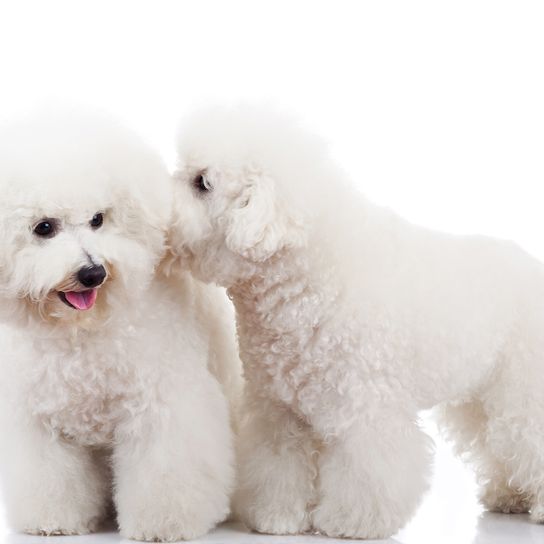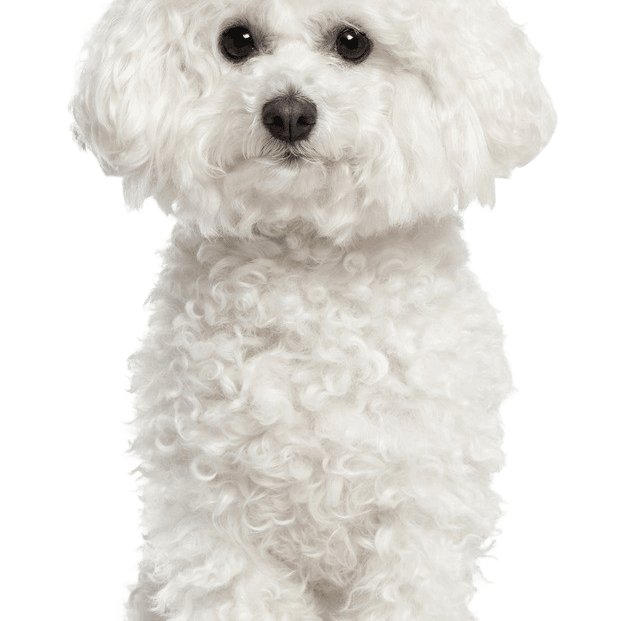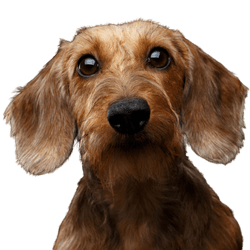Facts & Origin
Origin and history of the Bichon Frisé.
It is believed that the origin of this breed is in the Canary Islands. On the one hand, the Bichon Frisé was used for bartering among Spanish sailors, on the other hand, they were also welcome ambassadors for sailors arriving in port. The dogs were probably brought to Europe by sailors from Tenerife as early as the 14th century, and then came to France from Italy during the Renaissance. In its present form, it was eventually bred there as well as in Belgium, hence their official "breed origin" according to the FCI.
The Bichon Frisé was early considered a status symbol of the better society and was especially popular with the ladies, who appreciated it as a lap and companion dog. Thus, it can even be found on paintings of aristocrats of the 17th and 18th centuries. After the end of the World Wars, as with many other dog breeds, there was a sharp decline in its population. However, only French and Belgian breeders managed to preserve them.
Origin of the name
The name "Bichon" comes from its original pet name "Barbichon", which it got because of its resemblance to the Barbet, a French water dog; it probably descended from the latter, as did the Poodle. His official name is "Bichon à poil frisé". In French, "bichonner" also means to coddle or coiffure.
For a short time during the time of Napoleon III, he was also called Ténériffe.
Suitability and attitude
The Bichon Frisé is the epitome of a social dog, making him a great city dog. He is obedient, easy to manage, and can easily be taken anywhere (whether it's a hotel, restaurant, or traveling). He is also an excellent family dog who loves to play with children.
These happy, bright dogs do not need a lot of exercise. However, a daily walk of at least 30 minutes, should be mandatory. Training is also very easy, so this dog breed is also suitable as a first dog.
Hypoallergenic dog breed
However, dog hair allergy is usually not triggered by the hair itself, but by allergens found in the dog's saliva. When the dog licks its coat, the saliva with the allergens present in it sticks to the hair.
There is no dog breed that is actually completely hypoallergenic - but the Bichon Frisé is one of the dogs that are suitable for people allergic to animal hair. This is partly due to the fact that the breed does not shed much, and partly because the soft, curly coat traps the allergy-causing dander and dust, making the dog perfect for people who normally suffer from pet allergies.




| Alternate Name | Bichon à poil frisé, Bichon Frise |
| Origin | France |
| Life expectancy | 12 - 15 years |
| Care requirements | low-maintenance |
| Activity level | low |
| FCI group | Bichons and related breeds |
| AKC group | Toy Group |
| KC group | utility group |
Bichon Frisé mixes
Attitude, character and temperament of the breed
Typical character traits of the Bichon Frisé
The Bichon Frisé is a self-confident, spirited but also patient dog. Its most distinctive traits are its courage and alertness. At the same time, a breed specimen is never nervous, but very docile.
With early socialization, Bichon Frisés also get along well with conspecifics and other pets. He may bark if he suspects danger, but is not actually a yapper. These intelligent dogs are very suitable for new dog owners because of their uncomplicated nature.
Character
Usage
Breed diseases of the Bichon à poil frisé
The Bichon Frisé is normally a healthy, robust and long-lived dog. He can live up to 15 years in good health. However, as they age, many Bichon Frisés suffer from glaucoma. Certain diseases typical of the breed also occur:
- Patellar luxation
- Cushing's syndrome.
- Hip dysplasia
- Hypothyroidism (underactive thyroid gland)
Care of the Bichon Frisé
The diet, on the other hand, is relatively simple. The active dog usually has no problems with obesity and tolerates both raw and dry food. However, since the dogs' stomachs are relatively small, the food rations should be divided into several portions per day.
On the other hand, coat care should not be underestimated: in addition to daily brushing to remove dirt and tangles, a regular visit to the groomer is often required. This can prevent inflammation of the eyes and ears from any irritation.
Bichon Frisé purchase and breeding
To buy a Bichon Frisé puppy you should always contact one of the Bichon Frisé breeders. At the VDH you can find contact details of member clubs and reputable breeders of this breed. A Bichon Frisé from a breeder costs 1.500 Euro or more.
Alternatively, you can buy a Bichon Frisé from a shelter or animal welfare organization.


Breed characteristics of the Bichon Frisé
The dog breed is recognized by the FCI and is classified under No. 215 as Group 9 (Companion and Society Dogs), Section 1.1 (Bichons). The breed standard does not require a working test.
Size & Weight
These small dogs grow to between 25 cm and 29 cm in height, but for breeding purposes a variation of 1 cm more in the male and 2 cm less in the female is tolerated - as long as the proportions remain balanced and the sex differences are clearly discernible. They weigh about 5 kg, depending on size.
The gait
Typical for the Bichon Frisé is a lively and relaxed movement, which should be very reaching. When trotting, the head is carried high and the tail is bent over the back. This produces a good push from the hindquarters and the legs move parallel.
The head
The head should appear proportional to the body. The two eyes as well as the nose, altogether three black points on the white face, must form an equilateral triangle in a breed specimen. The skull feels rather flat with a faintly pronounced forehead fuche, although the coat makes it appear round. The skull is longer than the muzzle, but less broad than long, forming about 3/5 of the length of the head. The eyebrow arches are few, the pronounced stop not strongly accentuated.
The muzzle
The muzzle is rounded, well black, fine-grained and shiny. It sits on a muzzle with a straight nasal bridge (neither too deep nor too raised), which is very broad at the base and does not become too narrow towards the nose. It makes up in total the remaining 2/5 of the length of the head. The cheeks are flat.
The lips of the Bichon Frisé are thin, rather dry and they descend just enough to cover the lower lip. They are never heavy or pendulous, but black pigmented to the corner of the lips. Thus the lower lip must not be heavy, visible or droopy or show the mucous membrane when the muzzle is closed.
Typical of this breed is a broad upper and lower jaw, with six incisors regularly spaced below and six above. A scissor bite is the preferred bite position, but a pincer bite is also permitted. It should be complete.
The eyes & ears
The very dark, medium sized and rather round (not almond shaped) eyes of the Bichon Frisé are usually neither protruding nor slanted. The pigmentation of the eyelid rims is completely black. When the Bichon frisé looks forward, the white of the eyes may not be seen.
He also has drooping ears, which should be abundantly covered with hair. They are set slightly above the level of the eyes, forming an equilateral triangle and hanging vertically against the cheeks. The ear lobes, if directed forward, reach at least to the corner of the lips and have a maximum length of half a muzzle. The ears are mobile, especially when the dog's attention is aroused.
The trunk
The neck is quite long and is carried high and proud. It is round and narrow near the skull, but then gradually widens and finally merges seamlessly into the shoulders. Its length is about one third of the body length. There is no fold of skin on the neck.
The upper profile line of the Bichon Frisé is straight and essentially horizontal to the base of the tail, although the withers are quite pronounced. The equally horizontal back is muscular, the loins broad and well muscled, but slightly arched. The croup is also broad, slightly rounded and even very slightly sloping.
This breed of dog has a well-developed chest, reaching the elbow, and a pronounced sternum. The false ribs are rounded and not abruptly breaking off and the ribcage is quite long. Overall, the lower chest rises slightly to the belly, which itself is moderately raised. The flanks are raised and the skin there is thin and taut.
The tail
The tail, which should not be docked, is set slightly below the topline, but is usually bent high and gracefully over the back, carried at the level of the spine - without curling. The tip of the tail is hairy and does not touch the back, although the hair coat may fall down the back. The tail must not hang as soon as the dog starts to move.
The limbs
Viewed from the front, the legs are well set vertically and of medium bone. The shoulder is fairly sloping and the upper arm forms a good angle with the shoulders. The elbows are close to the body. The forearm, straight and vertical when viewed from all sides, leads into a pastern seen from the front as short and straight, but slightly sloping when viewed from the side.
The broad pelvis is evident on the hindquarters. The hind legs are generally well muscled and stand absolutely parallel as well as very vertical when viewed from behind. A broad, well-muscled thigh, well angulated and neither inward nor outward turned knees, as well as lower legs approximately as long as the thigh, make up the Bichon Frisé. The rear metatarsus is thus placed far down and is strongly pronounced, the metatarsus in general should be dry and without dewclaws.
The compact paws are round and stout, turning neither in nor out. The pads must be black, the claws are considered only preferably black.
The coat
The skin, well stretched over the entire body, is preferably dark pigmented, but without this showing through the coat. The scrotum is black.
An abundant coat is important for this breed: the top coat consists of loose corkscrew curls (hence the name "frisé", which is synonymous with "frizzy" or "curled") and the silky thin undercoat must be prominent. The coat is neither smooth, braided, wool-like nor matted.
Color-wise, the Bichon Frisé is found only in pure white. Before the dog has completed the first year of life, the coat may tend slightly to beige (champagne), but this shade must not cover more than 10% of the dog.
| Fur length | short |
| Fur | curly |
| Ear shape | Floppy Ear |
| Tail | fanned out |
| Anatomy | dainty |
| Size ♀ | 23 - 28 cm |
| Weight ♀ | 3 - 5 kg |
| Size ♂ | 23 - 30 cm |
| Weight ♂ | 3 - 5 kg |
| Suitable For | suitable for allergy sufferers, Children |
Colors
Known Diseases
Eye diseases
Often occur with allergies and intolerances.
Patellar luxation
Patellar luxation is the term used to describe a displacement of the kneecap, which is one of the most common causes of lameness in dogs.
FAQ
-
Between 700 and 2000 euros costs a Bichon Frise puppy. Depending on the breeding and whether the animals can be bought with papers.
-
Yes, a Bichon Frise is a great family dog and is also suitable for children.
-
A Bichon Frise needs little to average exercise. However, he likes to spend about 1-2 hours a day outdoors.
-
No, a Bichon Frise does not shed heavily. He is even considered a hypoallergenic dog breed.
-
The Bichon Frisé was used for bartering among Spanish sailors on the one hand, but on the other hand they were also welcome ambassadors for sailors arriving in port.
-
Yes, the coat of the Bichon Frisé requires a lot of care. It must be brushed daily.
-
A Bichon Frisé usually lives up to 15 years.























